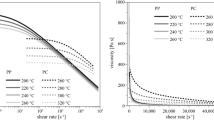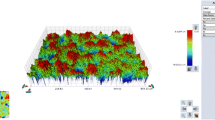Abstract
Micro-injection-moulding as a replication method is one of the key technologies for micro-manufacture. An important stage in micro-injection-moulding which can affect the accuracy and mechanical properties of the produced components is part de-moulding. During this stage, part-mould forces can cause a variety of defects to micro-parts, including stress marks, deformation, fracture and stretching of the polymer structures. Therefore, in this paper, the effects of different surface treatments on the de-moulding behaviour of parts with micro-features are investigated. In particular, the de-moulding of a representative micro-part was studied as a function of two different tool coatings, diamond-like carbon and silicon carbide, in combination with four process parameters, employing the design of experiment approach. In addition, the results obtained using different combinations of process parameters were analysed to identify the best processing conditions in regards to de-moulding behaviour of polycarbonate and acrylonitrile butadiene styrene micro-parts when utilising these two coatings.
Similar content being viewed by others
References
Nestler J et al (2006) A new technology platform for fully integrated polymer based micro optic fluidic systems, in 4 M 2006—Second International Conference on Multi-Material Micro Manufacture. Elsevier, Oxford, pp 35–38
Yao D, Kim B (2004) Scaling issues in miniaturization of injection molded parts. J Manuf Sci Eng 126(4):733–739. doi:10.1115/1.1813479
Haberstroh E, Brandt M (2002) Determination of mechanical properties of thermoplastics suitable for micro systems. Macromol Mater Eng 287(12):881–888. doi:10.1002/mame.200290023
Navabpour P et al (2006) Evaluation of non-stick properties of magnetron-sputtered coatings for moulds used for the processing of polymers. Surf Coat Tech 201(6):3802–3809. doi:10.1016/j.surfcoat.2006.06.042
Menges G, Mohren P (eds) (1993) How to make injection molds, 2nd edn. Hanser Gardner, New York
Kwak S et al (2003) Layout and sizing of ejector pins for injection mould design using the wavelet transform. Proc IME B J Eng Manufact 217(4):463–473
Heyderman LJ et al (2000) Flow behaviour of thin polymer films used for hot embossing lithography. Microelectronic Eng 54(3–4):229–245. doi:10.1016/S0167-9317(00) 00414-7
Daintith J (2005) The dictionary of science, 5th edn. OUP Oxford, Oxford
Pouzada AS, Ferreira EC, Pontes AJ (2006) Friction properties of moulding thermoplastics. Polym Test 25(8):1017–1023. doi:10.1016/j.polymertesting.2006.06.009
Sasaki T et al (2000) An experimental study on ejection forces of injection molding. Precis Eng 24(3):270–273. doi:10.1016/S0141-6359(99) 00039-2
Bataineh OM, Klamecki BE (2005) Prediction of local part-mold and ejection force in injection molding. J Manuf Sci Eng Trans ASME 127(3):598–604. doi:10.1115/1.1951785
Pontes AJ, Pouzada AS (2004) Ejection force in tubular injection moldings. Part I: effect of processing conditions. Polym Eng Sci 44(5):891–897. doi:10.1002/pen.20080
Pontes AJ et al (2005) Ejection force of tubular injection moldings. Part II: a prediction model. Polym Eng Sci 45(3):325–332. doi:10.1002/pen.20275
Crawford RJ (ed) (1987) Plastics engineering, 2nd edn. Pergamon, New York
Namseok L, Young-Kyn K, Shinill K (2004) Temperature dependence of anti-adhesion between a stamper with sub-micron patterns and the polymer in nano-moulding processes. J Phys D Appl Phys 35:1624–1629
Pham GT, Colton JS (2002) Ejection force modeling for stereolithography injection molding tools. Polym Eng Sci 42(4):681–693. doi:10.1002/pen.10981
Harris R, Newlyn H, Dickens P (2002) Selection of mould design variables in direct stereolithography injection mould tooling. Proc IME B J Eng Manufact 216(4):499–505
Kinsella ME et al (2005) Experimental determination of friction coefficients between thermoplastics and rapid tooled injection mold materials. Rapid Prototyping J 11(3):167–173. doi:10.1108/13552540510601291
Bacher W et al (1998) Fabrication of LIGA mold inserts. Microsyst Technol 4(3):117–119. doi:10.1007/s005420050110
Griffiths C et al (2007) Polymer inserts tooling for prototyping of micro fluidic components in micro injection moulding, in 4 M 2007. Proceedings of the 3 rd International Conference on Multi-material Micro Manufacture. Whittles, Dunbeath, pp 305–311
Mitterer C et al (2003) Industrial applications of PACVD hard coatings. Surf Coat Tech 163–164:716–722. doi:10.1016/S0257-8972(02) 00685-0
Heinze M (1998) Wear resistance of hard coatings in plastics processing. Surf Coat Tech 105(1–2):38–44. doi:10.1016/S0257-8972(98) 00449-6
Cunha L et al (2002) Performance of chromium nitride and titanium nitride coatings during plastic injection moulding. Surf Coat Tech 153(2–3):160–165. doi:10.1016/S0257-8972(01) 01690-5
Sawyer WG et al (2003) A study on the friction and wear behavior of PTFE filled with alumina nanoparticles. Wear 254(5–6):573–580
Haefliger D et al (2005) Dry release of all-polymer structures. Microelectronic Eng 78–79:88–92. doi:10.1016/j.mee.2004.12.013
Dearnley PA (1999) Low friction surfaces for plastic injection moulding dies—an experimental case study. Wear 225–229(Part 2):1109–1113. doi:10.1016/S0043-1648(98)00417-7
Van Stappen M et al (2001) Practice vs. laboratory tests for plastic injection moulding. Surf Coat Tech 142–144:143–145. doi:10.1016/S0257-8972(01) 01062-3
Voevodin AA, Donley MS, Zabinski JS (1997) Pulsed laser deposition of diamond-like carbon wear protective coatings: a review. Surf Coat Tech 92(1–2):42–49. doi:10.1016/S0257-8972(97) 00007-8
Heimberg JA, Wahl KJ, Singer IL (2001) Superlow friction behaviour of diamond like carbon coatings: Time and speed effects. Appl Phys Lett 78(17):2449. doi:10.1063/1.1366649
Zanini S et al (2007) Characterisation of SiO x C y H z thin films deposited by low-temperature PECVD. Vacuum 82(2):290–293. doi:10.1016/j.vacuum.2007.07.001
Uddin M et al (2006) Interfacial adhesion of spin-coated thin adhesive film on silicon substrate for the fabrication of polymer optical waveguide. J Electron Mater 35(7):1558–1565. doi:10.1007/s11664-006-0149-2
Grill A (2003) Diamond-like carbon coatings as biocompatible materials—an overview. Diam Relat Mater 12(2):166–170. doi:10.1016/S0925-9635(03) 00018-9
Yang H, Kang S-W (2000) Improvement of thickness uniformity in nickel electroforming for the LIGA process. Int J Mach Tools Manuf 40(7):1065–1072. doi:10.1016/S0890-6955(99) 00107-8
Kim SM, Kang S (2003) Replication qualities and optical properties of UV-moulded microlens arrays. J Phys D Appl Phys 36:2451–2456. doi:10.1088/0022-3727/36/20/005
Tang PT et al (2006) Indirect tooling based on micromilling, electroforming and selective etching, in 4 M 2006. In Second International Conference on Multi-Material Micro Manufacture
Hauert R (2003) A review of modified DLC coatings for biological applications. Diam Relat Mater 12(3–7):583–589
Roy R (ed) (1990) A primer on the Taguchi method. Van Nostrand Reinhold, New York
Author information
Authors and Affiliations
Corresponding author
Rights and permissions
About this article
Cite this article
Griffiths, C.A., Dimov, S.S., Brousseau, E.B. et al. Investigation of surface treatment effects in micro-injection-moulding. Int J Adv Manuf Technol 47, 99–110 (2010). https://doi.org/10.1007/s00170-009-2000-4
Received:
Accepted:
Published:
Issue Date:
DOI: https://doi.org/10.1007/s00170-009-2000-4




